Taylor Sheridan’s loose “Frontier trilogy” imagines the frontier as the site of America’s original sin.
Like Sicario and Hell or High Water, Wind River is set in what might be considered a modern-day equivalent of the “wild west.” It is a harsh and brutal world, one in which people fight a losing battle to make sense of that violence. Sicario imagined the frontier as Mexico, a tale of lawless retribution set against the backdrop of the already-lost War on Drugs. Hell or High Water imagined that frontier in Texas, a modern tale of bank robberies and land grabs. Wind River pushes that frontier to vast frozen surroundings of Wyoming, putting Native Americans in focus.
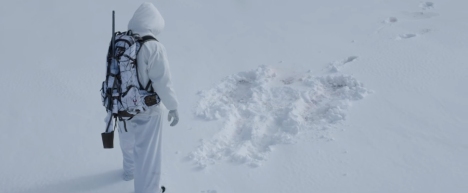
In the wild white yonder…
As the trilogy has moved North, it has also shifted tones. Sicario was confused and angry, struggling to explain the horrors that were unfolding. Hell or High Water blended that anger with a sense of wistful nostalgia, reflecting on the tragic irony of manifest destiny eroded by late capitalism. Wind River is just profoundly sad, a meditation on loss that seems more exhausted than angry. It is a tale about those people left behind on what remains of the frontier, about violence that is too easily overlooked and ignored. There is no rage here, no passion. There is just fatigue.
Wind River is a western set in the forgotten part of the west. It is a western set in the snow, on a Native American reservation. It is the story of a frontier that is too readily forgotten.
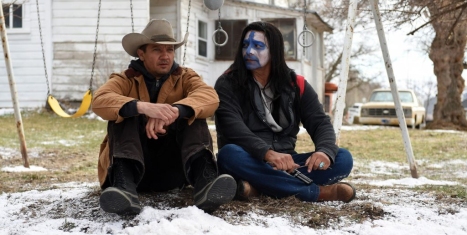
In cold blood.
Wind River plays almost as a fable against the backdrop of the American wilderness. The story has a broad and archetypal quality to it, and the script is almost lyrical at times; the movie opens with a scene of stark brutality juxtaposed with the reading of a beautiful poem. When FBI agent Jane Banner is introduced to Cory Lambert, she asks him what he does. “I hunt predators,” he explains. Wind River is the story of one such expedition, a modern mythic exploration of the frontier.
Modern American cinema has recently reengaged with the western as a genre. Perhaps this reflection is rooted in a sense of nostalgia, and perhaps as part of a broader reflection on the legacy of these stories. However, modern American cinema very rarely serves up a “straight” example of that most archetypal genre. Instead, contemporary iterations of those stories are filtered through the lens of other genres and framed in different ways. Perhaps this reflects the difficulty of selling westerns to a modern audience. Perhaps it hints at something more.
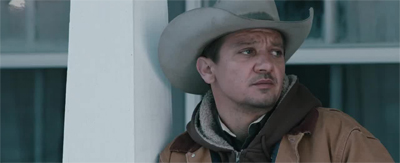
Renner, Renner.
The modern western tends to come flavoured with a dash of horror thrown in. The Revenant is practically a zombie movie set against the backdrop of the old frontier, a survival horror in which murderous gangs of characters seem to circle one another in a constant death spiral. The Hateful Eight imagines a western built off the template of The Thing; a bunch of strangers trapped in the snow together, lying to themselves and each other.
Other westerns are apocalyptic in tone. Logan positions itself as an update of Shane, set against the backdrop of a society in the midst of an apocalypse. Before War for the Planet of the Apes transforms itself into a classic biblical slavery epic, it is very much framed as an old-school revenge western; monkeys on horseback, riding through the frontier. Hell or High Water is perhaps a lower key example, but it fits the pattern. It positions mortgage foreclosures as twenty-first century land grabs, dispossessing the European settlers as they dispossessed the indigenous people.
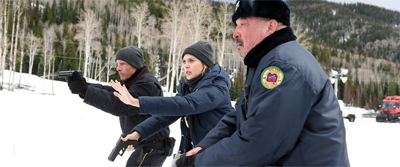
Wyoming stand-off.
Wind River feels very much like an extrapolation of the themes and ideas set up in Hell or High Water. In that film, various Native American characters seemed to appreciate the irony of the displacement of these European settlers, acknowledging that history was repeating itself and that the forces of capitalism demanded tribute. Wind River is much more engaged with the experiences of these indigenous people, of the Native Americans who have already lost their homes and their country.
There is a cruel irony in Wind River. As with many other modern westerns like The Revenant or The Hateful Eight or War for the Planet of the Apes, it forgoes the familiar and comforting desert imagery associated with the western genre in favour of the extreme opposite. The frontier in Wind River is cold and remote. It is white rather than brown. However, that white frontier serves as a tapestry against which sins may be laid bare. The white snow is frequently cast in different colours; a soft blue from reflected headlights, the deep red of blood.
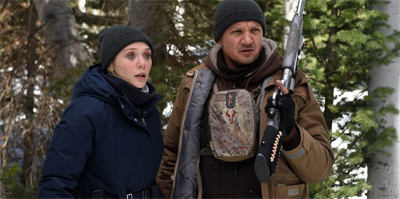
It can be hard to keep track.
In Wind River, the romantic American frontier is a half-remembered dream. In one extended sequence, a prelude to something truly horrific, a character ruminates on his time in California. He longs to return one day, to feel the peace that he associates with the end of the American frontier. However, the audience knows that he will never get to experience that peace again. That frontier is an illusion and a fantasy. It is very different from the reality presented in Wind River.
At another point, tracker Cory Lambert stumbles upon his old friend Martin, who is sitting in the garden and has painted his face in shades of blue. “It’s my death mask,” Martin explains. When Cory wonders whether that is part of some ancient Native American tradition, Martin dismisses the idea. “There’s nobody around to teach me the old ways,” he reflects. The Native American reservation in Wind River is a place of mourning. Lambert seems to believe that the only future for the children in the community is to get out, whether to college or to the army.

A banner year.
The reservation in Wind River is all that remains of the world that the Native Americans once knew. Cory explains that they have been stripped of everything but “the snow and the silence.” During a trip to a local drill site, patrolled by private security during the off-season, the reservation police are informed that they no longer have jurisdiction. The encroaching capitalism that threatened the Howard family in Hell or High Water has already staked its claim.
In theory, Wind River is a mystery movie. It follows an investigation into the murder of a young woman on the reservation. FBI agent Jane Banner is tasked with doing a preliminary investigation, enlisting Cory Lambert to help her understand the situation into which she has wandered. However, Wind River is decidedly disinterested in the formal structure of such a mystery. There are no suspects. There are no red herrings. There no villainous monologues. There are no taunting phone calls. Wind River is not interested in a salacious murder mystery.

Snow escape.
Instead, Wind River is permeated by this sense of entropy and decay. The film is never structured as a “whodunnit” or even a “whydunnit.” The guilty party is identified quite early in the film based purely on simple geography; there is no other possible suspect for the crime in question. There is no grand cover-up. While Wind River is driven by anger, that anger is never exciting or thrilling. That anger expresses itself through frustration and resignation.
The obstacles facing Banner are irritatingly low key. Banner cannot get the coroner to declare the death a murder, so she cannot call in other agents to assist in the investigation. The reservation police force is already undermanned and overstretched, so they do not have the resources to conduct a proper investigation. The film’s closing text serves to contextualise all of these developments, suggesting that this is simple the reality facing these communities.
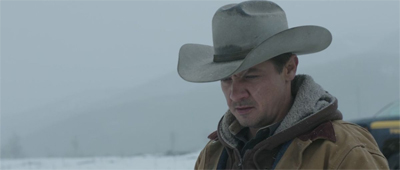
Cory principles.
When Wind River does depict the horrible crime at its centre, the sequence is defined by a feeling of creeping inevitability rather than any sense of shock. The violence is portrayed as the inevitably byproduct of how this community has been treated, of familiar attitudes taken to extremes. Wind River portrays this as the ultimate expression of the fantasy of the “wild west”, the casual indifference to the horrific brutality inflicted upon these communities. The violence in Wind River is horrifying, but the film also suggests it is an organic result of a certain attitude.
There is a debate to be had about the decision to tell this story from the perspective of two outside characters; Banner is an FBI agent from Florida who flew in from Nevada, while Lambert is a white man who married into the reservation community. Both Elizabeth Olsen and Jeremy Renner do great work in their roles, but it seems fair to wonder whether it is appropriate to tell this story through the eyes of two European settlers. It is an interesting debate about representation in media.
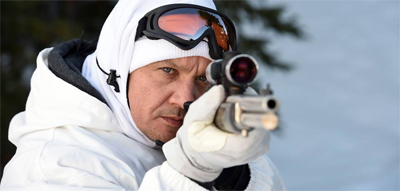
Day of the Hunter.
Wind River seems to justify this creative decision by framing the murder mystery as a tale of generation guilt. This is a story that plays as the culmination of centuries of abuse and violence perpetrated against the indigenous population, and unfolds against that backdrop. Banner and Lambert work as characters who share some passive complicity in that wider social context, even if they are not directly responsible.
Wind River never suggests that these characters can make things right, because things are too far gone for that. The film is not so naive or patronising. However, Wind River does suggest that both Lambert and Banner have a moral responsibility to do right by this marginalised and victimised community. It is a powerful and affecting narrative, one which treats its indigenous characters with respect and dignity; Gil Birmingham and Graham Greene work very well in supporting roles.
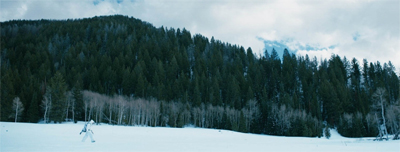
Chilling crimes.
Wind River is only the second film to be directed by Taylor Sheridan. Although Sheridan has an impressive CV as both a writer and an actor, his only previous directing credit was a low-budget horror named Vile. However, it appears that Sheridan was paying attention to the work of the directors who adapted his previous two screenplays; Wind River owes a lot to Denis Villeneuve’s direction of Sicario and David Mackenzie’s direction of Hell or High Water.
While Sheridan lacks the polished edge of Villeneuve or the clarity of Mackenzie, he does understand that his location is a character in its own right. but it does acknowledge that they can be aware of these issues. Working with cinematographer Ben Richardson, Sheridan captures the sense of this sparse white wasteland, a crisp and clean slate upon which these sins might be exposed. This landscape is further developed through the atmospheric score from Nick Cave and Warren Ellis, who also provided a voice for the rugged desert surroundings of Hell or High Water.
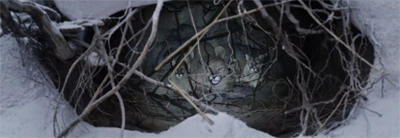
The Lion in Spring.
Wind River is a beautiful and powerful piece of cinema.
Filed under: Non-Review Reviews | Tagged: american frontier, film, frontier, jeremy renner, Manifest Destiny, Movie, non-review review, review, taylor sheridan, wond river |




















That’s a great and very thoughtful review. For me, this is one of the best films of 2017. The landscape is an additional character and the issues raised are compelling and disturbing, without preaching at the viewer.
It really is one of my favourites of the year so far.
Anyone else notice the numerous similarities to Twin Peaks? FBI agent sent to rural area to investigate death of a young, sexually active woman? There’s other connections. Indeed, if you Google “Twin Peaks Wind River” you’ll find out Wind River is where Teresa Banks body was found, the murder that started what became the Laura Palmer investigation.
Note: I mean this as no slight to the movie. It was very good.
Interesting. I’ll be rewatching it soon. And I’ll make a note of it.